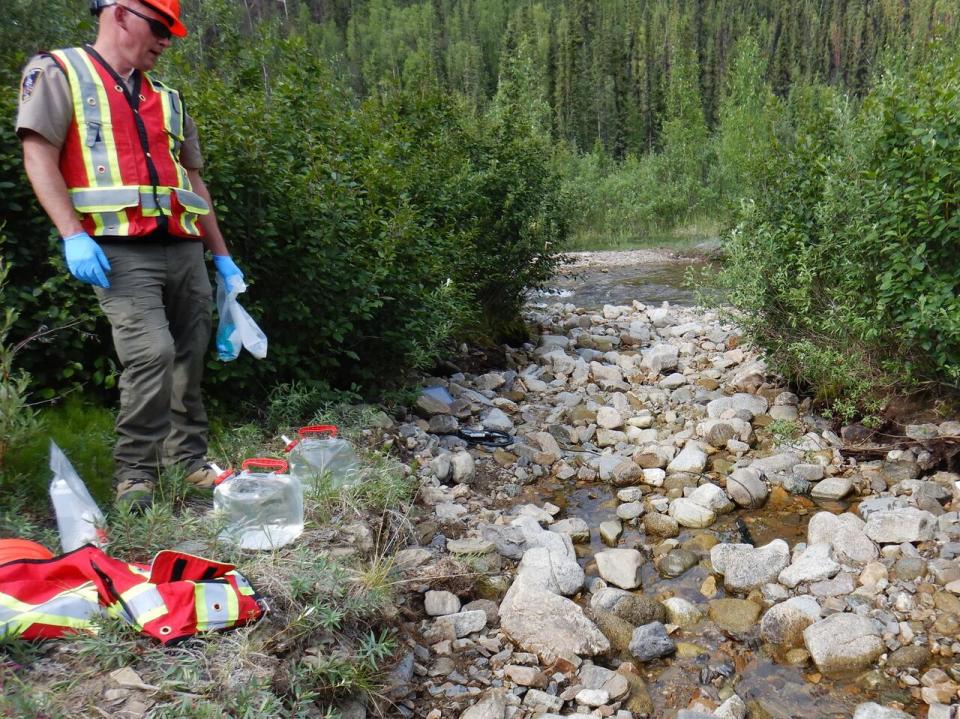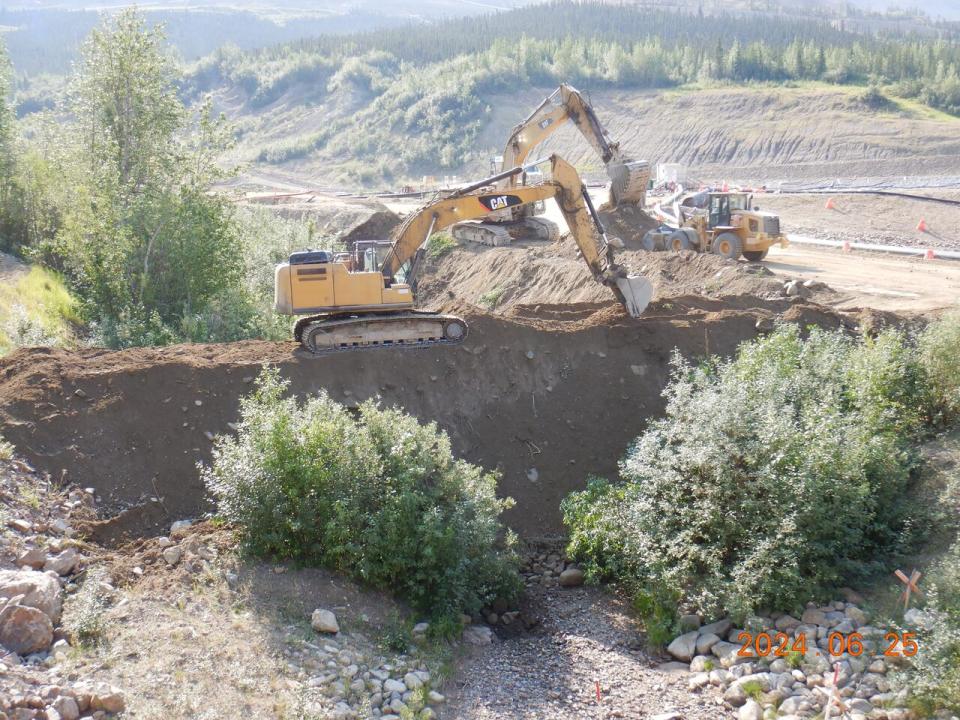4 days after Eagle mine slide, Yukon gov't still 'not clear' on damage, or possible cyanide release
Yukon government officials say they're still trying to determine the extent of the damage at the Eagle mine site, more than four days after a "significant" slide damaged infrastructure and indefinitely halted operations at the mine, and potentially released cyanide into the environment.
They also said it will likely be next week before water-sample results could indicate whether any cyanide has escaped containment and contaminated nearby waterways.
A group of Yukon government officials from several departments, along with the territory's acting chief medical officer, held a technical briefing for media on Friday morning. It was the first such briefing since the incident on Monday, and officials had little to say that wasn't already known.
"The slide appears to have damaged some mine infrastructure and the extent of this damage is not clear at this point. It is too early to say what caused the heap leach failure," said Kelly Constable, the government's director of mineral resources.
Heap leaching is process that uses a cyanide solution to extract gold from stacked layers of ore. The incident on Monday involved a landslide on the ore stack. It was a "multi-bench failure," Constable said, that was "significant in size."
She could not say how much material was moved in the landslide, or how much cyanide may have been involved.
"We know how much is applied to the facility, and we know how much the storage capacity is but I don't know at this point what the storage capacity was at the time of the event, so I can't answer that," Constable said.

Government officials say Victoria Gold, which owns and operates the mine, built two containment dams immediately after the slide. Those dams "appear to have contained any solution" on site, said Russell McDiarmid, head of major mines for the Yukon government.
Water sampling was done on the mine site from any pools that had collected, as well as from nearby Haggart Creek, McDiarmid said. Those samples were then sent to Burnaby, B.C., for analysis as that can't be done in the territory.
It will likely be at least Tuesday before any of those sample results are in, officials said.
The territorial government has said that the risk to drinking water in Mayo, Yukon, about 85 kilometres south of the mine, is "extremely low," as the community is upstream from the mine.
Officials also said they're talking with Victoria Gold "daily" about what the company is doing on site. The company has not said anything publicly about the incident since issuing a brief statement on Monday.
However, in an "open note to all employees," sent by the company on Tuesday and obtained by CBC News, Victoria Gold's vice-president and general manager Tim Fisch said the "major slope failure" would mean some temporary layoffs at the mine "as we work through a myriad of very complex and intricate issues."
"We are currently investigating the cause of the incident as well as developing an understanding of the operational consequences of the failure," the letter reads.
"Given the magnitude of the event, it will be some time before we are again fully operational."
The mine employs about 500 people when at full operations.

Also at Friday's briefing, a spokesperson for the Yukon Workers' Safety and Compensation Board (YWSCB) said that there was one reported injury associated with the incident, and that two workers at the site had received first aid treatment. They said there were no serious injuries, and did not provide any other details about the people who were hurt.
Officials had said earlier that there were no reports of injuries after the slide. The YWSCB said employers have 72 hours to report a workplace injury, and the one associated with the heap leach failure was reported toward the end of that period.
Some local First Nations have voiced frustration over what they see as a "downplaying" of the incident by government officials. Chief Dawna Hope of the First Nation of Na-Cho Nyäk Dun, on whose traditional land the Eagle mine site sits, said on Thursday that she was dissatisfied with the response so far to what she called a "catastrophic event."
Addressing the officials at the end of Friday's briefing, Cord Hamilton, an engineer who said he's been retained by Na-Cho Nyäk Dun, also decried what he sees as a tepid response so far.
"It is beyond doubt there is a release of cyanide," he said.
"We really want to see a higher level of response, we know more is coming at us. Makeshift dams are not the answer. Really significant action is required."
Hamilton also questioned the wait for water sample results.
"Yes it takes a long time to get results. But dead fish show up. We haven't heard, has that been looked for in Haggart Creek? In South McQuesten River? Has that kind of inspection been done?" Hamilton asked officials.
"You don't need a test to find dead fish."
Hamilton didn't get a response before the briefing was ended.
Officials promised more weekly briefings, starting next Thursday.
Slide could have 'disastrous effects' on chinook salmon, says advisory body
Also on Friday, the Yukon Salmon Sub-Committee, a non-governmental advisory body, issued a statement saying it was "deeply concerned" about what the incident at the Eagle mine could mean for chinook salmon in downstream waterways.
Chinook runs in the Yukon River watershed have been in steep decline in recent years and the committee says the mine slide "presents another potential stressor with serious implications for salmon at all life-stages."
"Emerging fry, rearing juveniles, and the disastrously low runs of adult returning Yukon River Chinook salmon need safe passage in a healthy waterway at this critical time."
Earlier this year, Canada and Alaska agreed to a seven-year moratorium on any chinook fishing on the Yukon River, in an effort to help the species rebound.
The Eagle mine incident "provides difficult implications internationally," the Yukon Salmon Sub-Committee statement reads.
The committee is calling for a "full-scale response" to the heap leach failure, with "immediate and consistent downstream monitoring."
"There have been known examples in Canada and internationally where landslides and failures using heap leach facilities and chemicals such as cyanide, have had disastrous effects on fish-bearing streams and habitats," the statement reads.


